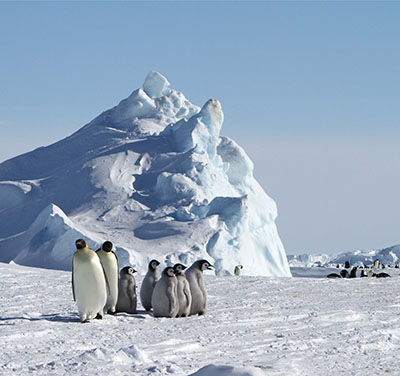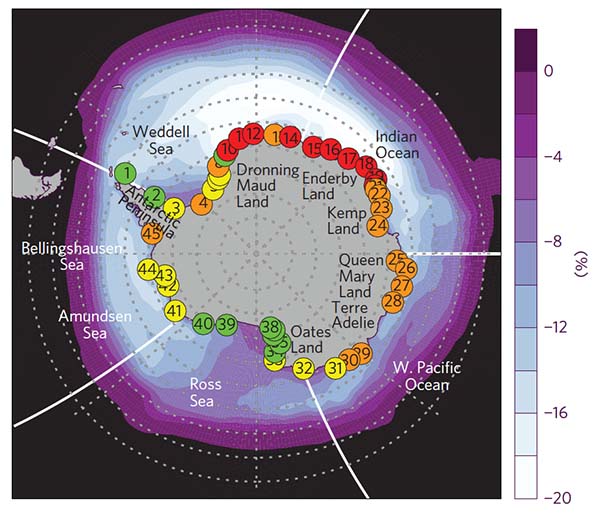Emperor penguins on the decline?
Modeling the future of a charismatic bird
Jul 30, 2014 - by Staff
Jul 30, 2014 - by Staff
July 30, 2014 | Emperor penguins, the large, charismatic birds known from their frequent film and TV appearances, are in danger. A collaborative research project is drawing attention to the impending plight of the emperors. By 2100, according to a new study, their numbers will have fallen by around 19% and will continue to decline, qualifying the species for endangered status.
Emperor penguin communities entirely ring the continent of Antarctica. Of the 45 known colonies, only one has been extensively studied for decades, and most of the others have never been visited by humans, nor are they likely to be. Emperors live on sea ice off the coast of the continent, and the amount of ice plays a major role in determining the health of a colony. Too much ice and the penguins have a long, debilitating walk to the sea and food; too little ice and the colony is more exposed and vulnerable to predation.

A colony of emperor penguins at Australia's Snow Hill Island, October 2009. (Photo by Jenny Varley, Wikimedia Commons.)
Stéphanie Jenouvrier (Woods Hole Oceanographic Institution) is an expert on penguin life, and she wanted to project the size of emperor populations into the future as Earth’s climate warms. The problem, she says, was her “limited background on climate science.” Meanwhile, at NCAR, senior scientist Marika Holland is a climate scientist with a longstanding specialty in modeling sea ice changes, although she has never been to Antarctica and has never seen an emperor penguin.
Aware of Holland’s previous work, Jenouvrier contacted her and Julienne Stroeve at the University of Colorado’s Cooperative Institute for Research in Environmental Sciences. The three of them collaborated on preliminary studies published in 2009. Jenouvrier received a fellowship from CIRES and worked in Boulder for almost a year, collaborating closely with Holland, Stroeve, Mark Serreze at the CIRES National Snow and Ice Data Center, and other scientists on a follow-up study, published in 2012, and on their most extensive update, recently published in Nature Climate Change.
The biologists used long-term data from the one well-studied emperor colony, off the coast of Terre Adélie, to estimate the relationship between sea ice and rates of breeding success and survival of chicks. They used the record of penguin population and sea ice concentrations at Terre Adélie to estimate vital rates (births/deaths) and population dynamics at each colony.
The next challenge was to project sea ice changes over the rest of the 21st century and relate that to the health of each penguin community. Sea ice off Antarctica does not behave uniformly: although the total area of sea ice around the continent has increased somewhat in recent years, the trends vary by region during the course of a year and over longer periods. Sea ice must therefore be studied in the relatively small segments that host individual colonies, in order to assess the viability of penguin populations. At first, says Holland, the biologists and climate modelers spoke two different languages, which was “a bit of a barrier.” The frequent interchanges during Jenouvrier’s year in Boulder helped bridge that gap, she adds.
The sea ice scientists began with a group of 20 or so climate models and settled on a widely used midrange scenario of emissions produced for the Intergovernmental Panel on Climate Change called SRES A1B. Once the penguin population models and sea ice change models were set, climate projections were fed into the penguin population models. Due to inherent uncertainties in the models, Jenouvrier ran tens of thousands of computer simulations to achieve the results that the team published.
They found that sea ice will generally decline and its variability will increase by the end of this century. As a result, the simulations indicate that emperor populations will increase by around 10% through midcentury, but then decline to 19% below current levels by 2100. One group of 7 colonies facing the Ross Sea will still be non-threatened by that time, although with a reduced population. On the other side of the continent, facing the Indian Ocean and Weddell Sea, 10 colonies will face quasi-extinction. Most of the rest will qualify as endangered.
The collaborative nature of a study like this, Holland says, allows the expertise of NCAR scientists to inform such other fields as biology and economics to better understand the global system. The researchers conclude that the emperor penguin is “fully deserving of Endangered status due to climate change, and can act as an iconic example of a new global conservation paradigm for species threatened by future climate change.”
|
Writer Collaborating institutions Funders |
|
Stéphanie Jenouvrier, Marika Holland, Julienne Stroeve, Mark Serreze, Christophe Barbraud, Henri Weimerskirch and Hal Caswell, Projected continent-wide declines of the emperor penguin under climate change, Nature Climate Change (2014), doi:10.1038/nclimate2280

Annual mean change of sea ice concentrations (SIC) between the twentieth and twenty-first centuries and conservation status of emperor penguin colonies by 2100. SIC projections were obtained from a subset of atmosphere-ocean general circulation models. Dot numbers refer to each colony evaluated, with dot color showing conservation status (red = quasi-extinct, orange = endangered, yellow = vulnerable, green = not threatened). (Figure 1 from Jenouvrier et al., Projected continent-wide declines of the emperor penguin under climate change, doi:10.1038/nclimate2280; image courtesy Nature Climate Change.)